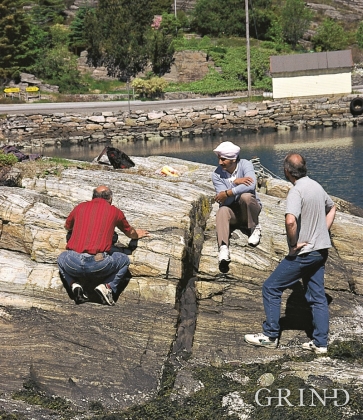Published: 31.07.2015 | Author: Haakon Fossen
Geologists from all over the world come to study the veined bedrock (the dark stripe in the picture) at Spildepollen. Now, the veins lie under a new fisherman's housing establishment. Similar veins, even if not as clearly visible, can be seen in the steep road-cut in the bend about 50 metres to the right of the boathouse in the picture. (Haakon Fossen)
IN CONTACT WITH THE MANTLE
The oceanic crust of the North Sea was subjected to a lot of stretching both in Permian and Triassic times, and later in the Jurassic. This stretching resulted in the North Sea collapsing in and also to large faults forming west of Hordaland and on the mainland. Austefjorden in Sund follows one of these faults.
The straight-as-an-arrow Auste Fjord is carved out along a nearly straight geological structure. This structure cuts deeply into the earth's crust. Just below the mantle, magmatic rock flowed, some time about 250 million years ago. The magma solidified to veins along some of the fractures in the Auste Fjord structure.
These veined rocks are a fair bit older than the majority of similar veins in Sunnhordaland, but they are thought to be closely related, despite their age difference. Geologists believe that the formation of these basaltic veins can have been caused by forces that were released along the fractures in the crust in Permian and Triassic time. Later, ice carved out valleys and fjords in a north-south direction in these zones of fractured bedrock. Examples of fjords and valleys that were created in this way, in addition to Auste Fjord, are Lokksundet Sound, Romarheimsdalen Valley and the Mundheimsdalen–Kikedalen valleys.
The road cut in the bend before the road crossing at Spildepollen is one of several places where the veined rocks from Permian times are visible.
- Fossen, H. 1998. Advances in understanding the post-Caledonian structural evolution of the Bergen area, West Norway. Norsk Geologisk Tidsskrift 1998, 78,33–46.
- Løvlie, R.; Mitchell, J. G. 1982. Complete remagnetization of some Permian dykes from western Norway induced during burial/uplift. Physics of the Earth and Planetary Interiors 30:415–421.




